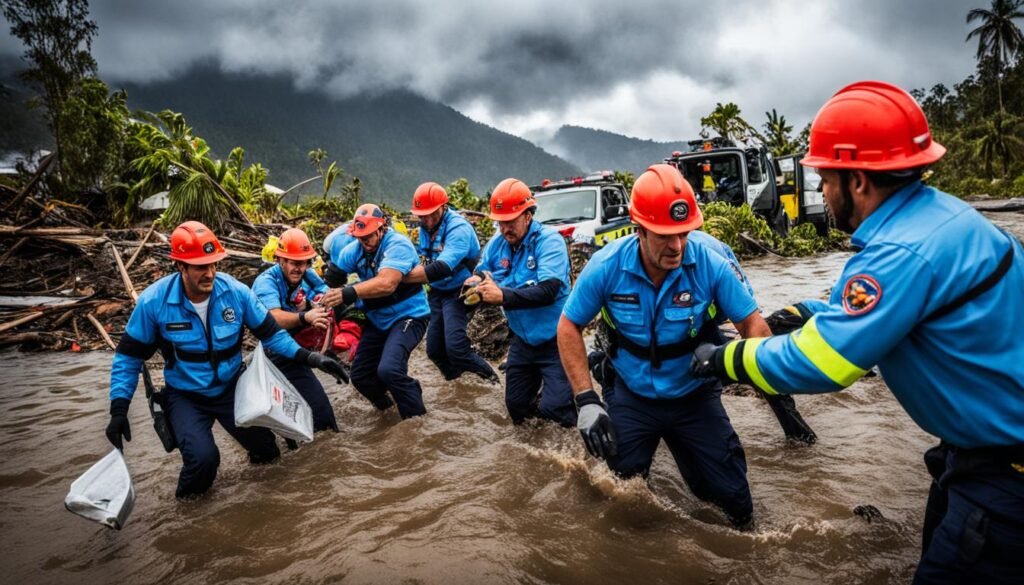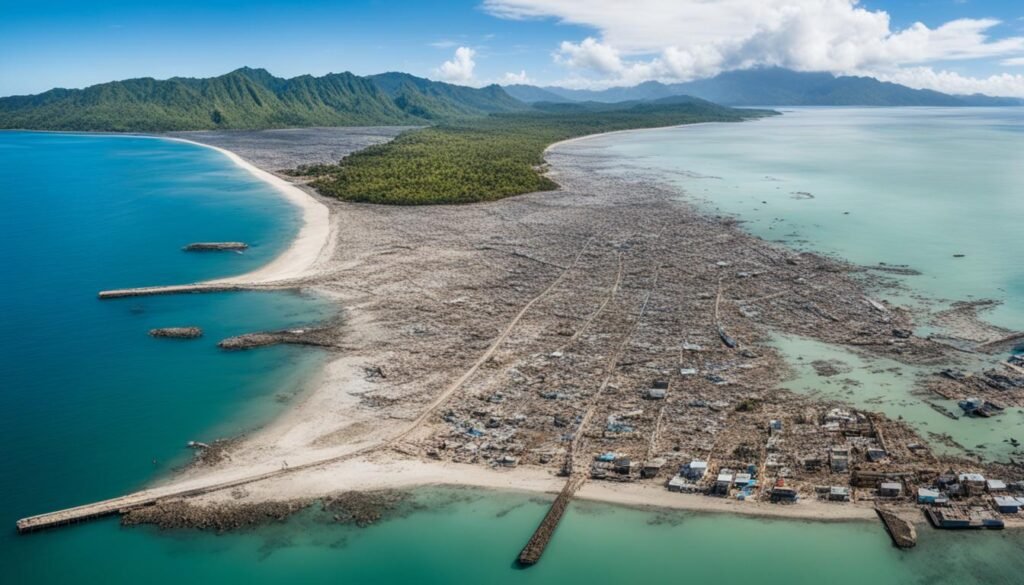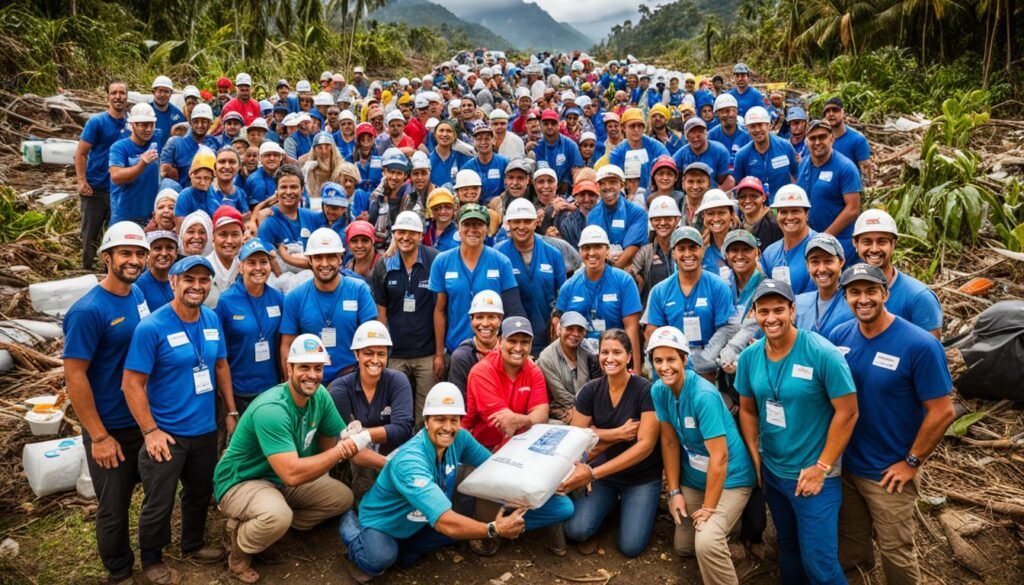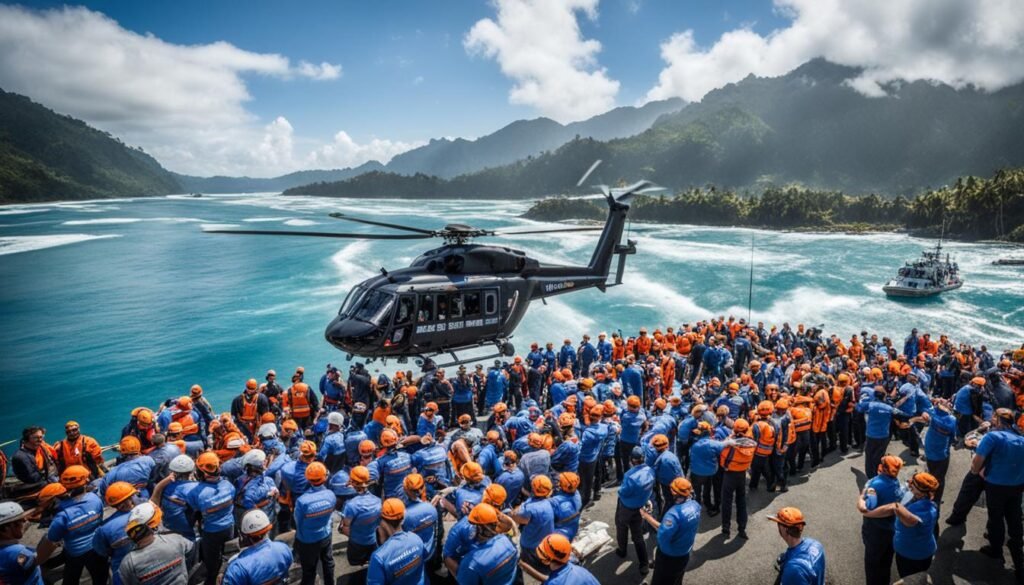The Indo-Pacific’s Geopolitical Landscape holds significant strategic importance, spanning from the Indian Ocean to the Pacific Ocean. With more than half of the world’s population and nearly two-thirds of the global economy, the region is a hub of activity. It is also home to seven of the world’s largest militaries and supports millions of jobs. However, the region faces numerous challenges, including geopolitical tensions, security threats, climate change, and the ongoing COVID-19 pandemic. These challenges necessitate effective humanitarian aid and disaster relief efforts in the Indo-Pacific.
Key Takeaways: Indo-Pacific’s Geopolitical Landscape
- The Indo-Pacific region is strategically important, housing a vast population and a significant portion of the global economy.
- Geopolitical tensions, security threats, climate change, and the COVID-19 pandemic pose challenges for the region.
- Effective humanitarian aid and disaster relief efforts are crucial to address these challenges.
- Collaborative action and regional cooperation are key to achieving successful disaster response in the Indo-Pacific’s complex geopolitical landscape.
- Strengthening multilateral mechanisms and investing in resilience-building initiatives can enhance the region’s capacity for disaster response.
Importance of the Indo-Pacific in Global Geopolitics
The Indo-Pacific region holds immense significance in the realm of global geopolitics. Its strategic position serves as a vital link between major trading routes, encompassing key sea lanes such as the South China Sea and the Indian Ocean. This unique maritime location gives rise to a multitude of geopolitical challenges as different nations contend for influence and dominance within the region. The maintenance of maritime security in the Indo-Pacific is not only crucial for the economic stability of the region itself but also fundamental to global trade and overall stability.
To understand the importance of the Indo-Pacific in global geopolitics, one must recognize its strategic value. The region’s sea lanes facilitate the flow of international trade, serving as vital arteries for the movement of goods and resources. These sea routes connect major economic powerhouses, such as the United States, China, Japan, and Australia, and are essential for sustaining their economic vitality.
However, alongside the economic opportunities, the Indo-Pacific also confronts geopolitical challenges that stem from the competition for influence. The region is home to several major powers, each seeking to expand their reach and shape the trajectory of the Indo-Pacific. China’s assertive actions in the South China Sea, for instance, have raised concerns among neighboring countries and sparked geopolitical tensions.
The maintenance of maritime security in the Indo-Pacific is of paramount importance, as it directly affects not only the economies and security of the region but also the broader stability of the global community. A disruption or conflict in this region could have far-reaching consequences that extend well beyond its immediate boundaries.
It is therefore imperative to prioritize efforts aimed at ensuring stability, cooperation, and effective governance in the Indo-Pacific. The maintenance of maritime security involves upholding freedom of navigation, managing territorial disputes, and fostering multilateral cooperation among nations in the region.
In recent years, countries have recognized the need for collaborative approaches to address the geopolitical challenges in the Indo-Pacific. Initiatives such as the Quadrilateral Security Dialogue (Quad), which involves the United States, Japan, Australia, and India, focus on promoting a rules-based Indo-Pacific, enhancing maritime security, and furthering cooperation in the region. These collective efforts reinforce the significance of the Indo-Pacific in global geopolitics, and highlight the imperative of sustained engagement and collaboration.
Maritime Security and Strategic Stability
The Indo-Pacific’s maritime significance extends beyond its role in trade and geopolitics. The region’s sea lanes serve as essential conduits for energy resources, with a significant proportion of global oil and gas passing through these waters. Any disruption, whether due to piracy, territorial disputes, or other security threats, can have severe consequences for energy supplies and global stability.
Maritime security encompasses a broad range of issues, including ensuring the safety of shipping, combating transnational crime, and preventing the proliferation of weapons of mass destruction. It also involves addressing non-traditional security challenges such as illegal fishing, maritime terrorism, and environmental degradation.
Maintaining maritime security in the Indo-Pacific is therefore not only critical for the stability, prosperity, and safety of the region but also essential for the interconnected global community. Collaborative efforts among nations, including information sharing, joint naval exercises, and capacity building, are crucial in safeguarding maritime security and promoting strategic stability.
Key Geopolitical Challenges in the Indo-Pacific
The Indo-Pacific region faces a multitude of geopolitical challenges that have significant implications for regional and global dynamics. These challenges include territorial disputes, power competition, regional rivalries, and changing alliances. One such example is the longstanding territorial disputes in the South China Sea, that involve overlapping territorial claims by countries such as China, Vietnam, the Philippines, Malaysia, and Brunei.
Adding to the geopolitical challenges are the evolving dynamics of major powers. China’s rapid rise as an economic and military powerhouse has generated concerns among neighboring countries and other global actors. The United States, Japan, India, and Australia, among others, are closely monitoring China’s growing influence and actively engaging in the Indo-Pacific region to protect their interests and preserve a rules-based order.
The Indo-Pacific also faces security threats related to the proliferation of weapons, including nuclear and ballistic missile technologies. Addressing these complex challenges requires a comprehensive and collaborative approach that involves open dialogue, constructive engagement, and the promotion of shared interests and values.
The United States’ Indo-Pacific Strategy
The United States has devised a comprehensive Indo-Pacific strategy to address the geopolitical challenges in the region. This strategy is centered around the promotion of a free and open Indo-Pacific, fostering connections within and beyond the region, driving prosperity, bolstering security, and building regional resilience to transnational threats. By implementing this strategy, the United States aims to strengthen its long-term position and commitment to the Indo-Pacific while countering the influence of countries like China.
The United States recognizes the strategic competition in the Indo-Pacific and understands the significance of maintaining a strong presence to safeguard its interests. This strategy emphasizes the importance of cooperation with allies and partners, as well as upholding shared values and international law. Through these collaborative efforts, the United States aims to counteract the challenges posed by strategic competitors and promote stability in the region.
Key Elements of the Indo-Pacific Strategy
- Advancing a free and open Indo-Pacific: The United States seeks to uphold the principles of freedom of navigation, peaceful dispute resolution, and fair trade in the Indo-Pacific region. By promoting an open and inclusive regional architecture, the United States aims to foster a conducive environment for economic growth, innovation, and connectivity.
- Building connections: The strategy emphasizes the importance of strengthening bilateral and multilateral relationships with Indo-Pacific countries, as well as international organizations. By deepening engagement, the United States aims to bolster diplomatic ties, enhance military cooperation, and expand economic partnerships to reinforce regional stability and prosperity.
- Driving prosperity: The United States aims to promote economic development and growth in the Indo-Pacific by leveraging its expertise, resources, and investments. Through initiatives such as the Indo-Pacific Economic Vision, the United States seeks to support infrastructure development, expand trade opportunities, and foster sustainable economic practices that benefit all countries in the region.
- Bolstering security: Recognizing the importance of a secure environment for regional stability and economic growth, the United States is committed to working with allies and partners to enhance maritime security, counter transnational threats, and deter aggression. This involves strengthening defense capabilities, conducting joint military exercises, and sharing intelligence and information to address shared security concerns.
- Building regional resilience: The strategy focuses on enhancing the ability of Indo-Pacific countries to withstand and respond effectively to transnational threats, including natural disasters and public health emergencies. By promoting capacity building, disaster preparedness, and public health cooperation, the United States aims to build regional resilience and minimize the impact of crises.
The United States’ Indo-Pacific strategy recognizes the need for collective action and collaboration to address the complex challenges in the region. It underscores the United States’ commitment to the Indo-Pacific and its determination to promote the values of a free, open, and prosperous region. Through strategic competition and cooperation, the United States aims to create a stable and secure Indo-Pacific that benefits all countries involved.
Multilateral Mechanisms for Collective Disaster Response
Effective disaster response requires collective action and coordination among multiple countries and organizations. In the Indo-Pacific region, several multilateral mechanisms are in place to facilitate and strengthen collective disaster response efforts. These mechanisms serve as platforms for policy coordination, operational cooperation, resource mobilization, and confidence-building.
One such mechanism is the Association of Southeast Asian Nations (ASEAN), which plays a pivotal role in promoting regional cooperation and coordination during disasters. ASEAN member states collaborate closely to share information, coordinate rescue and relief operations, and provide support to affected countries. This regional cooperation enhances the collective capacity to respond swiftly and effectively to disasters in the Indo-Pacific.
The Quadrilateral Security Dialogue (Quad) is another multilateral mechanism that focuses on addressing shared challenges, including disaster response and resilience. Comprising the United States, Japan, Australia, and India, the Quad seeks to enhance coordination and collaboration in areas such as maritime security, disaster relief, and humanitarian assistance. The Quad partners engage in joint exercises, information sharing, and capacity-building initiatives to strengthen the collective disaster response capabilities in the region.
The Indian Ocean Rim Association (IORA) is a regional forum comprising 22 member states, promoting cooperation and dialogue on various issues, including disaster risk reduction and management. IORA facilitates the exchange of best practices, knowledge sharing, and capacity building through working groups and technical cooperation mechanisms. This collaborative approach strengthens the region’s ability to mitigate the impact of disasters and respond effectively.
The Lancang Mekong Cooperation (LMC) mechanism focuses on fostering cooperation among the six Mekong River countries – Cambodia, China, Laos, Myanmar, Thailand, and Vietnam. The LMC facilitates joint efforts in disaster management and response, sharing expertise, and resource allocation. By working together, these countries enhance their collective capacity to mitigate the impacts of floods, droughts, and other natural disasters in the Mekong region.
The FRANZ (France, Australia, and New Zealand) arrangement is a trilateral mechanism aimed at providing rapid and coordinated assistance in the Pacific region during emergencies and disasters. Together, these countries support affected Pacific Island nations through disaster preparedness, response planning, and joint exercises. This collaborative approach strengthens the regional response capacity and contributes to the overall collective disaster response in the Indo-Pacific.
Advantages of Multilateral Mechanisms for Collective Disaster Response
Multilateral mechanisms for collective disaster response offer several advantages in addressing the challenges faced in the Indo-Pacific. These mechanisms:
- Promote regional cooperation and coordination
- Enable information sharing and best practice exchange
- Facilitate resource mobilization and allocation
- Enhance operational cooperation and joint exercises
- Build confidence and trust among participating countries
By leveraging these advantages, multilateral mechanisms strengthen the overall regional capacity to respond effectively to disasters, minimize loss of life and property, and support affected communities in their recovery.
Implementing comprehensive and well-coordinated disaster response strategies requires continuous efforts to improve these multilateral mechanisms and foster regional cooperation. By prioritizing collective action, coordination, and capacity building, the Indo-Pacific can better prepare for and respond to future disasters, ultimately protecting lives and minimizing the humanitarian and economic impact of disasters in the region.
| Multilateral Mechanism | Main Objectives | Contributions to Collective Disaster Response |
|---|---|---|
| Association of Southeast Asian Nations (ASEAN) | Promote regional cooperation and coordination | Facilitate information sharing, joint exercises, and resource mobilization during disasters |
| Quadrilateral Security Dialogue (Quad) | Enhance coordination and collaboration among member states | Strengthen joint disaster response capabilities, share best practices, and engage in capacity building initiatives |
| Indian Ocean Rim Association (IORA) | Foster cooperation and knowledge exchange | Promote best practices in disaster risk reduction and management, contribute to regional resilience |
| Lancang Mekong Cooperation (LMC) | Enhance cooperation among Mekong River countries | Improve collective capacity for disaster management, expertise sharing, and resource allocation |
| FRANZ (France, Australia, and New Zealand) arrangement | Provide rapid and coordinated assistance in the Pacific | Support affected Pacific Island nations through joint exercises, planning, and disaster preparedness initiatives |
Challenges and Opportunities in Collective Disaster Response
As the Indo-Pacific region grapples with humanitarian crises and natural disasters, collective disaster response plays a critical role in saving lives and mitigating the devastating impacts. However, this response is not without its challenges and opportunities. The ongoing COVID-19 pandemic, climate crisis, and geopolitical tensions shape the landscape of disaster response in the region, dictating the need for increased cooperation, adaptability, and resilience.
The Impact of the COVID-19 Pandemic
The COVID-19 pandemic has posed unique challenges to collective disaster response in the Indo-Pacific. With countries focusing on managing the health crisis, disaster response efforts have had to adapt and incorporate measures to prevent the spread of the virus. Mobilizing resources, including militaries, logistics, and healthcare capabilities, has become more complex due to the need for additional protocols and safeguards.
Despite these challenges, the pandemic has also presented opportunities for innovation and collaboration. Countries in the region have leveraged technology and data analytics to enhance disaster response coordination and communication. Virtual platforms have facilitated knowledge sharing and real-time information exchange, enabling more efficient and effective decision-making.
The Intensifying Climate Crisis
The climate crisis has amplified the severity and frequency of natural disasters in the Indo-Pacific. More frequent and intense storms, cyclones, floods, and wildfires pose significant challenges to disaster response efforts. These disasters strain existing resources, infrastructure, and response capacities, necessitating a coordinated and collective approach.
At the same time, the climate crisis has also created opportunities to prioritize climate resilience in disaster response strategies. Incorporating climate adaptation and mitigation measures into response plans can contribute to long-term sustainability and reduce the vulnerability of communities in the face of future climate-related disasters.
Geopolitical Tensions and Cooperation
Geopolitical tensions and rivalries in the Indo-Pacific region can undermine collective disaster response efforts. Competing interests, differing priorities, and historical disputes may hinder effective coordination and hinder the flow of assistance during emergencies. Balancing these tensions with the need for cooperation is crucial for a comprehensive and coordinated response.
However, the Indo-Pacific region also offers opportunities for enhanced cooperation and collaboration among nations. Recognizing the shared interest in disaster response and the need to address collective challenges can foster greater regional unity. By setting aside differences and prioritizing mutual aid and support, countries can develop joint strategies, share resources, and strengthen their collective response capacity.
Overall, while the challenges of the COVID-19 pandemic, climate crisis, and geopolitical tensions are formidable, they also present opportunities to reshape and strengthen collective disaster response in the Indo-Pacific. By leveraging technological advancements, prioritizing climate resilience, and fostering regional cooperation, the region can build a more resilient and efficient response system to protect the lives and livelihoods of those affected by disasters.
Strengths and Weaknesses of Multilateral Mechanisms
Each multilateral mechanism in the Indo-Pacific region has its strengths and weaknesses when it comes to facilitating collective disaster response. Understanding these strengths and weaknesses is crucial for effective coordination and resource mobilization in times of crises.
ASEAN
The Association of Southeast Asian Nations (ASEAN) has a well-established regional disaster response system, making it one of the key players in the Indo-Pacific. ASEAN’s strengths lie in its track record of successful coordination and its ability to bring together countries in the region to respond to disasters collectively. By promoting trust, dialogue, and coordination, ASEAN facilitates efficient disaster response efforts.
The Quad
The Quadrilateral Security Dialogue, or the Quad, focuses on military cooperation and security in the Indo-Pacific. While originally established to address security challenges, the Quad’s strengths can also contribute to effective disaster response. The military capabilities and resources of its member countries (the United States, Australia, India, and Japan) can be mobilized to provide immediate assistance during disasters and support post-disaster recovery efforts.
IORA
The Indian Ocean Rim Association (IORA) promotes regional collaboration on various issues, including disaster management. Its strengths lie in facilitating knowledge sharing, information exchange, and best practices among member countries in the Indian Ocean region. By fostering cooperation and coordination, IORA plays a vital role in enhancing the preparedness and response capabilities of its member states in the face of disasters.
LMC
The Lancang-Mekong Cooperation (LMC) framework fosters cooperation among the countries along the Mekong River. Although not explicitly focused on disaster response, the LMC’s strengths in promoting dialogue, regional connectivity, and sustainable development contribute to a more coordinated approach during times of disasters. Close collaboration among the member countries can facilitate the sharing of resources, expertise, and best practices in disaster management.
FRANZ
The FRANZ arrangement between France, Australia, and New Zealand enables rapid response in the Pacific during disasters. Its strengths lie in the quick mobilization of resources, including personnel, supplies, and funding, to provide immediate assistance to affected countries. The FRANZ arrangement showcases the importance of international collaboration and collective action in humanitarian aid and disaster relief efforts.
While these multilateral mechanisms possess notable strengths, they also face certain challenges that can hinder effective collective action. Power dynamics among member countries, differing priorities, and limited resources are some of the weaknesses that need to be addressed to optimize their role in facilitating disaster response in the Indo-Pacific.
| Mechanism | Strengths | Weaknesses |
|---|---|---|
| ASEAN | – Well-established regional disaster response system – Successful coordination track record |
– Power dynamics among member countries – Differing priorities |
| The Quad | – Military cooperation and security focus – Immediate assistance capabilities |
– Limited resources for long-term recovery efforts – Potential political tensions |
| IORA | – Regional collaboration promotion – Knowledge sharing and best practices dissemination |
– Varying levels of disaster management capacities among member states |
| LMC | – Cooperation among Mekong River countries – Connectivity and sustainable development focus |
– Limited explicit focus on disaster response – Varying levels of disaster management capacities among member states |
| FRANZ | – Rapid response capabilities – International collaboration in the Pacific |
– Limited geographical scope |
Policy Recommendations for Enhancing Collective Disaster Response
To tackle the complex challenges of disaster response in the Indo-Pacific region, several policy recommendations can be considered. These recommendations aim to strengthen collective action and improve the efficiency of disaster response efforts.
1. Strengthening Multilateral Mechanisms
One key recommendation is to focus on strengthening the existing multilateral mechanisms in the Indo-Pacific region. This involves promoting closer cooperation and coordination among organizations such as ASEAN, the Quad, IORA, LMC, and the FRANZ arrangement. By enhancing policy coordination and resource mobilization, these mechanisms can facilitate more effective disaster response. The key is to leverage the strengths of each mechanism and foster collaboration between them.
2. Prioritizing Cross-Sectoral Collaboration and Information Sharing
Effective disaster response requires collaboration across sectors and the sharing of timely and accurate information. Policymakers should prioritize efforts to enhance cross-sectoral collaboration, involving government agencies, humanitarian organizations, non-governmental organizations, and the private sector. By working together and sharing expertise, resources, and data, stakeholders can improve preparedness and response capabilities.
3. Investing in Capacity Building and Training Programs
Investing in capacity building and training programs is crucial for enhancing collective disaster response. Governments and organizations should allocate resources to improve the response capacity of countries in the Indo-Pacific. This can include training emergency responders, establishing early warning systems, and developing disaster management plans. Building skills and knowledge among local communities and organizations is essential for a swift and effective response.
4. Promoting Inclusivity and Local Expertise
Incorporating local perspectives and expertise in disaster planning and decision-making processes is vital for ensuring a context-appropriate and efficient response. Policymakers should actively involve local communities, indigenous groups, and non-governmental organizations in the planning and implementation of disaster response strategies. By recognizing and integrating local knowledge, policies can be more effective and responsive to the unique needs and challenges of the Indo-Pacific region.
By implementing these policy recommendations, the Indo-Pacific region can enhance its collective capacity to respond to disasters. Strengthening multilateral mechanisms, prioritizing collaboration and information sharing, investing in capacity building, and incorporating local expertise will contribute to a more coordinated and efficient disaster response efforts. These recommendations pave the way for a more resilient and prepared Indo-Pacific in the face of future disasters.
Importance of Regional and International Collaboration
Regional collaboration and international cooperation are essential components for effective disaster relief efforts in the Indo-Pacific region. By working together, countries can pool their resources, share expertise, and coordinate their response efforts more efficiently. Regional organizations such as ASEAN, IORA, and the LMC (Lancang Mekong Cooperation) serve as platforms for information exchange, policy coordination, and collective decision-making, facilitating collaboration among member states.
The key advantage of regional collaboration is the ability to address disaster relief challenges that are specific to the Indo-Pacific. These organizations understand the unique regional dynamics, enabling them to tailor their approaches and strategies to the needs of the affected areas. They can also tap into their collective knowledge and experiences to develop best practices and standard operating procedures for disaster response.
International cooperation, on the other hand, brings a broader perspective and additional support to disaster relief efforts in the Indo-Pacific. Partnerships with non-regional actors, such as the United States and other international humanitarian organizations, contribute valuable resources and expertise. The involvement of these actors expands the capacity for disaster response and enhances the effectiveness of relief efforts.
Disaster relief requires a multi-dimensional approach, addressing not only immediate needs but also long-term recovery and resilience-building. Therefore, the participation of non-governmental organizations (NGOs), humanitarian agencies, and the private sector is crucial. These entities contribute specialized skills, technologies, and funding, complementing the efforts of governments and regional organizations.
Furthermore, regional and international collaboration fosters a sense of solidarity and shared responsibility in addressing disaster relief challenges. It strengthens diplomatic ties, builds trust among nations, and promotes a culture of cooperation in the face of adversity. By working together, countries in the Indo-Pacific can more effectively respond to disasters and reduce the impact on affected communities.
“The scale and complexity of disasters in the Indo-Pacific require collective action and strong partnerships. Regional and international collaboration provide the necessary framework for effective disaster relief efforts, ensuring a coordinated and comprehensive response.”
It is important to note that collaboration alone is not enough; it must be supported by proper coordination mechanisms, effective communication channels, and shared resources. Additionally, the establishment of clear protocols and agreements enhances the efficiency and effectiveness of collaborative efforts.
In summary, regional collaboration and international cooperation play a vital role in disaster relief efforts in the Indo-Pacific. By leveraging the collective resources and expertise of countries, regional organizations, NGOs, and international partners, we can strengthen our capacity to respond to disasters and support affected communities in their recovery and resilience-building efforts.
The Role of the United States in Humanitarian Aid and Disaster Relief
When it comes to humanitarian aid and disaster relief in the Indo-Pacific region, the United States plays a crucial role. Through its various agencies and departments, such as USAID and the Department of Defense, the United States provides essential support and assistance during times of crisis.
One of the key contributions of the United States in disaster response and recovery efforts is the provision of immediate relief supplies. This includes essential items like food, water, shelter, and medical assistance, which are vital for addressing the immediate needs of affected populations. Additionally, the United States offers logistical support to facilitate the efficient distribution of aid and resources.
Furthermore, the United States engages in regional cooperation initiatives, recognizing the importance of collective action in addressing disasters. These initiatives involve collaborating with regional partners and organizations to strengthen the overall response capacity of the Indo-Pacific. Through capacity-building programs and training exercises, the United States works towards enhancing preparedness and fostering a more resilient region.
In times of disaster, the United States stands shoulder to shoulder with our regional partners, extending a helping hand and working together to ensure a coordinated and effective response. Our commitment to regional engagement is unwavering, as we recognize the significance of collective efforts in tackling the challenges posed by natural disasters.
The United States’ collaboration with regional partners and organizations contributes to a more comprehensive and coordinated approach to humanitarian aid and disaster relief in the Indo-Pacific. By working together, countries can pool their resources, share expertise, and implement efficient strategies to address the multifaceted challenges of disasters in the region.
In summary, the United States plays a vital role in providing humanitarian aid and disaster relief in the Indo-Pacific. Through its various agencies and collaborative efforts, the United States contributes to immediate relief efforts, capacity building, and regional engagement. By working in partnership with others, the United States aims to ensure a well-coordinated and effective response to disasters, ultimately helping to build a more resilient Indo-Pacific.
| Contributions of the United States in Humanitarian Aid and Disaster Relief |
|---|
| Provision of immediate relief supplies such as food, water, shelter, and medical assistance |
| Logistical support for the efficient distribution of aid and resources |
| Engagement in regional cooperation initiatives and capacity-building programs |
| Collaboration with regional partners and organizations for a more comprehensive and coordinated approach |
Strengthening Resilience and Preparedness for Future Disasters
Building resilience and preparedness is crucial for addressing future disasters in the Indo-Pacific. By investing in early warning systems, disaster risk reduction initiatives, and community-based preparedness programs, the region can enhance its capacity to mitigate the impact of future disasters.
One key area to focus on is strengthening infrastructure, particularly critical lifeline systems such as transportation, communication, and healthcare. By ensuring the robustness and redundancy of these systems, the Indo-Pacific can better withstand and respond to the challenges posed by future disasters.
Capacity building plays a pivotal role in empowering local communities and organizations to effectively handle disaster response. Through targeted training programs and knowledge sharing efforts, the region can enhance its collective response capacity and foster a culture of preparedness.
Collaboration with international partners and organizations is also essential in building resilience. By leveraging technical expertise and support, the Indo-Pacific can develop and implement comprehensive strategies for resilience-building. This collaboration can also facilitate cross-learning and exchange of best practices among different regions facing similar challenges.
Investing in Resilience and Preparedness
Investing in long-term resilience and preparedness is crucial to anticipate and mitigate the impact of future disasters. By prioritizing these efforts, the Indo-Pacific can proactively address the evolving risks and challenges it faces.
- Develop and implement comprehensive early warning systems to provide timely information and alerts to vulnerable populations.
- Promote disaster risk reduction initiatives that focus on proactive measures such as land-use planning, building codes, and ecosystem-based approaches.
- Empower local communities through community-based preparedness programs, ensuring they have the necessary knowledge and resources to respond effectively during disasters.
- Strengthen critical lifeline systems, including transportation, communication, and healthcare infrastructure, to ensure continuity of essential services during and after disasters.
- Facilitate capacity building and training programs for local organizations and first responders, enabling them to effectively coordinate and respond to disaster situations.
- Promote knowledge sharing and collaboration among regional and international partners to foster cross-learning and the exchange of best practices in disaster resilience.
Enhancing Regional Resilience: A Case Study
To illustrate the benefits of investing in resilience and preparedness, let’s take a look at a case study from the Indo-Pacific region: Japan.
“Japan’s experience with natural disasters, particularly earthquakes and tsunamis, has shaped its approach to resilience and preparedness. The country has invested heavily in early warning systems, including the world-famous earthquake early warning system that provides alerts to millions of people. Japan has also implemented stringent building codes and regulations that ensure the structural integrity of buildings and infrastructure. Through regular disaster drills and public awareness campaigns, Japan has fostered a culture of preparedness and community engagement. These efforts have significantly contributed to minimizing the impact of disasters and saving lives.”
By learning from Japan’s example and implementing similar strategies tailored to their specific contexts, countries in the Indo-Pacific can enhance their resilience and preparedness for future disasters.
Also Read:- The Gaza Conundrum: Reshaping Global Geopolitical Dynamics
Image: A visual representation highlighting the importance of resilience in disaster preparedness and response.
Conclusion
The Indo-Pacific’s geopolitical landscape presents unique challenges and opportunities for humanitarian aid and disaster relief. The region’s strategic importance, coupled with ongoing geopolitical tensions, the climate crisis, and the COVID-19 pandemic, necessitate collective action and regional cooperation in responding to disasters.
Strengthening multilateral mechanisms such as ASEAN, Quad, IORA, LMC, and FRANZ is crucial for better coordination, policy alignment, and resource mobilization during times of disasters. By enhancing collaboration, countries in the Indo-Pacific can address power dynamics and differing priorities, enabling more effective collective action and disaster response.
Investing in resilience-building initiatives, prioritizing capacity building, and promoting cross-sectoral collaboration are essential for preparing the region to face future disasters. By working together, countries can overcome challenges and create a more resilient and prepared Indo-Pacific, better equipped to handle the complex and evolving geopolitical landscape.
In conclusion, collective action and regional cooperation are pivotal in ensuring an efficient and coordinated response to disasters in the Indo-Pacific. By strengthening multilateral mechanisms, enhancing coordination and collaboration, and investing in resilience-building initiatives, countries in the region can navigate the challenges and opportunities presented by the Indo-Pacific’s geopolitical landscape, and build a more resilient and prepared future.
FAQs
Q: What is the significance of humanitarian aid and disaster relief in the Indo-Pacific region?
A: Humanitarian aid and disaster relief are crucial in the Indo-Pacific region due to its susceptibility to natural disasters, conflicts, and the presence of major powers with strategic interests in the area.
Q: How does the geopolitical landscape of the Indo-Pacific impact humanitarian aid and disaster relief efforts?
A: The geopolitical competition in the Indo-Pacific greatly influences the distribution and allocation of aid, with various countries vying for influence and strategic advantages in the region geostrategic.
Q: What role do major powers in the Indo-Pacific play in driving humanitarian aid and disaster relief initiatives?
A: Major powers such as China, India, Australia, and others are actively involved in providing aid, shaping policies, and influencing the outcomes of humanitarian efforts in the region diplomacy.
Q: How does the concept of multipolarity affect humanitarian aid and disaster relief operations in the Indo-Pacific?
A: The multipolar nature of the Indo-Pacific region, with multiple power centers and competing interests, adds complexity to aid operations and relief efforts, leading to strategic dialogues and collaborations.
Q: What are some key organizations involved in coordinating humanitarian aid and disaster relief in the Indo-Pacific?
A: Organizations such as the Carnegie Endowment for International Peace, Air University, and strategic dialogues across the Indo-Pacific region play vital roles in coordinating and implementing aid and relief strategies geopolitics of the indo-pacific.
Q: How does the Indo-Pacific region’s security policy influence humanitarian aid and disaster relief strategies?
A: The security policies of countries within the Indo-Pacific region impact the planning, execution, and effectiveness of humanitarian aid and disaster relief efforts, ensuring the safety and well-being of affected populations.
Q: What are some recent developments in the humanitarian aid and disaster relief landscape of the Indo-Pacific region?
A: Recent developments in September 2021 have highlighted the increased focus on Indo-Pacific security, with major powers like China, India, and the European Union expanding their presence and influence in the region.
Q: What is the significance of humanitarian aid and disaster relief in the Indo-Pacific region?
A: Humanitarian aid and disaster relief play a crucial role in addressing the challenges faced by countries in the Indo-Pacific region, especially in the wake of natural disasters and emergencies.
Q: How does the geopolitical landscape of the Indo-Pacific affect humanitarian efforts?
A: The complex geopolitical dynamics in the Indo-Pacific region impact the distribution and effectiveness of humanitarian aid, influenced by factors such as strategic interests and competition among major powers.
Q: How are strategic dialogues utilized in driving humanitarian aid in the Indo-Pacific?
A: Strategic dialogues among nations within the Indo-Pacific region are essential in coordinating efforts and resources for humanitarian aid and disaster relief, enhancing collaboration and response capabilities.
Q: What role does South Asia play in humanitarian aid and disaster relief efforts in the Indo-Pacific?
A: South Asia’s geographical location and presence of major powers make it a key player in shaping humanitarian aid strategies and disaster relief initiatives in the broader Indo-Pacific region.
Q: How does the concept of multipolar influence humanitarian aid distribution in the Indo-Pacific?
A: The multipolar structure of the Indo-Pacific region impacts the decision-making processes related to humanitarian aid allocation, reflecting the diverse interests and strategies of various stakeholders.
Q: What are the implications of competition in the Indo-Pacific on humanitarian aid efforts?
A: The competitive nature among nations in the Indo-Pacific region can either facilitate or hinder humanitarian aid and disaster relief operations, depending on the alignment of interests and cooperation levels.
Q: How do geopolitical contest and strategic interests drive humanitarian aid policies in the Indo-Pacific?
A: Geopolitical contest and strategic interests among countries in the Indo-Pacific region influence the prioritization and allocation of resources for humanitarian aid, shaping the overall relief strategies.
Source Links
- https://www.whitehouse.gov/wp-content/uploads/2022/02/U.S.-Indo-Pacific-Strategy.pdf
- https://usnwc.libguides.com/c.php?g=866733&p=8875558
- https://www.preventionweb.net/media/81749/download?startDownload=true









